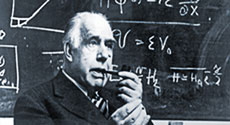Niels Bohr Lecture by prof. Paul Chaikin
Quantifying hidden order out of equilibrium
Talk by: Paul Chaikin, Silver professor of physics at New York University

Abstract: While the equilibrium properties, states, and phase transitions of interacting systems are well described by statistical mechanics, the lack of suitable state parameters has hindered the understanding of non-equilibrium phenomena in divers settings, from glasses to driven systems to biology.
Here we introduce a simple idea enabling the quantification of organization in non-equilibrium and equilibrium systems, even when the form of order is unknown. The length of a losslessly compressed data file is a direct measure of its information content.
We use lossless data compression to study several out-of-equilibrium systems, and show that it both identifies ordering and reveals critical behavior and even some critical exponents in dynamical phase transitions. Our technique should provide a quantitative measure of organization in systems ranging from condensed matter systems in and out of equilibrium, to cosmology, biology and possibly economic and social systems.
About Paul Chaikin
From Brooklyn Paul Chaikin went to Stuyvesant HS, to a physics BS from Caltech (1966), to a physics PhD from UPenn in (1971) with a thesis on Kondo superconductors. He joined the physics faculty at UCLA in 1972 and studied thermopower, charge and spin density waves, and high magnetic field phenomena mostly in organic superconductors. The lore of actually seeing the microscopics of a system led him into soft matter where he helped develop techniques to measure elasticity and motion and understand interparticle interactions. Both hard and soft matter interests continued after joining the faculty at UPenn (1983), the staff at Exxon Research (1983) and the faculty at Princeton (1988). His interests in geometry and topology led to founding contributions to nanolithography with diblock copolymers, and studies of defect motion and annealing. His most well known contribution is showing that ellipsoids (e.g. M&M’s© ) pack more densely than spheres and helping to explain why. In 2005 he helped found the Center for Soft Matter Research and joined the faculty at NYU. His more recent research centers on artificial active matter, colloids, self-assembly, self-replication, DNA nanotechnology, topological defects on curved surfaces and quantifying order in non-equilibrium phenomena.
Chaikin is a Julius Silver Professor of Physics at NYU, a member of the National Academy of Science and a Fellow of the American Academy of Arts and Sciences, the American Physical Society and the Institute of Physics (London). He was an A. P. Sloan Foundation Fellow and a John Simon Guggenheim Fellow and received the 2018 Oliver E. Buckley Condensed Matter Prize from the American Physical Society.
|

 Niels Bohr Lectures
Niels Bohr Lectures